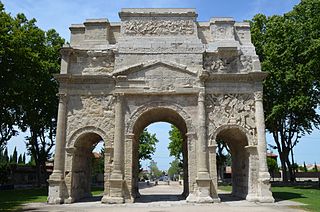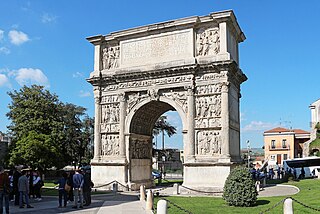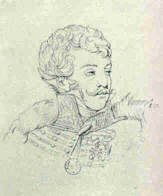
The Arc de Triomphe de l'Étoile, often called simply the Arc de Triomphe, is one of the most famous monuments in Paris, France, standing at the western end of the Champs-Élysées at the centre of Place Charles de Gaulle, formerly named Place de l'Étoile—the étoile or "star" of the juncture formed by its twelve radiating avenues. The location of the arc and the plaza is shared between three arrondissements, 16th, 17th (north), and 8th (east). The Arc de Triomphe honours those who fought and died for France in the French Revolutionary and Napoleonic Wars, with the names of all French victories and generals inscribed on its inner and outer surfaces. Beneath its vault lies the Tomb of the Unknown Soldier from World War I.

The Place Charles de Gaulle, historically known as the Place de l'Étoile, is a large road junction in Paris, France, the meeting point of twelve straight avenues including the Champs-Élysées. It was renamed in 1970, following the death of President Charles de Gaulle. It is still often referred to by its original name; the nearby Métro and RER station retains the designation Charles de Gaulle–Étoile. Paris's Axe historique cuts through the Arc de Triomphe, which stands at the centre of the Place Charles de Gaulle.

The Axe historique refers to a straightly aligned series of thoroughfare streets, squares, monuments and buildings that extend from the centre of Paris, France, to the west-northwest of the city. It is also known as the Voie Triomphale.

A triumphal arch is a free-standing monumental structure in the shape of an archway with one or more arched passageways, often designed to span a road, and usually standing alone, unconnected to other buildings. In its simplest form, a triumphal arch consists of two massive piers connected by an arch, typically crowned with a flat entablature or attic on which a statue might be mounted or which bears commemorative inscriptions. The main structure is often decorated with carvings, sculpted reliefs, and dedications. More elaborate triumphal arches may have multiple archways, or in a tetrapylon, passages leading in four directions.

Argentine is a station on Line 1 of the Paris Métro, located on the boundary between the 16th arrondissement and the 17th arrondissement, in the western part of the city.

The Arch of Constantine is a triumphal arch in Rome dedicated to the emperor Constantine the Great. The arch was commissioned by the Roman Senate to commemorate Constantine's victory over Maxentius at the Battle of the Milvian Bridge in AD 312. Situated between the Colosseum and the Palatine Hill, the arch spans the Via Triumphalis, the route taken by victorious military leaders when they entered the city in a triumphal procession. Dedicated in 315, it is the largest Roman triumphal arch, with overall dimensions of 21 m (69 ft) high, 25.9 m (85 ft) wide and 7.4 m (24 ft) deep. It has three bays, the central one being 11.5 m (38 ft) high and 6.5 m (21 ft) wide and the laterals 7.4 m (24 ft) by 3.4 m (11 ft) each. The arch is constructed of brick-faced concrete covered in marble.

The Arc de Triomphe du Carrousel is a triumphal arch in Paris, located in the Place du Carrousel. It is an example of Neoclassical architecture in the Corinthian order. It was built between 1806 and 1808 to commemorate Napoleon's military victories in the Wars of the Third and Fourth Coalitions. The Arc de Triomphe de l'Étoile, at the far end of the Champs-Élysées, is about twice the size; designed in the same year but not completed until 1836.

The Arch of Trajan is an ancient Roman triumphal arch in Benevento, southern Italy. It was erected in honour of the Emperor Trajan across the Via Appia, at the point where it enters the city.

Makaravank is a 10th-13th century church complex near the Achajur village of Tavush Province, Armenia, located on the slope of Paitatap Mountain. The complex of Makaravank ranks among Aghtamar, Bgheno-Noravank, Gandzasar with its originality, richness and variety of ornaments and occupies an important place in Armenian architecture.

The Triumphal Arch of Orange is a triumphal arch located in the town of Orange, southeast France. There is debate about when the arch was built, but current research that accepts the inscription as evidence favours a date during the reign of emperor Augustus. It was built on the former via Agrippa to honor the veterans of the Gallic Wars and Legio II Augusta. It was later reconstructed by emperor Tiberius to celebrate the victories of deceased general Germanicus over the German tribes in Rhineland. The arch contains an inscription dedicated to emperor Tiberius in AD 27. Along with the Roman Theatre of Orange, the Triumphal Arch was inscribed on the UNESCO World Heritage List in 1981 because of its exceptional preservation.

Porte d'Aix is a triumphal arch in Marseille, in the south of France, marking the old entry point to the city on the road from Aix-en-Provence. The classical design by Michel-Robert Penchaud was inspired by the triumphal arches of the Roman Empire. The Porte d’Aix was initially conceived in 1784 to honour Louis XVI and to commemorate the Peace of Paris (1783) that ended the American Revolutionary War. Following the restoration of the Bourbon monarchy in 1814–15, the project was resumed in 1823, now to commemorate French victories in the Spanish Expedition, notably at the Battle of Trocadero, August 31, 1823. It was eventually completed in 1839, with a more general theme of victory.

Jean-Antoine Marbot, also known to contemporaries as Antoine Marbot, was a French general and politician. He belongs to a family that has distinguished itself particularly in the career of arms, giving three generals to France in less than 50 years.

The following is a list of the 660 names inscribed under the Arc de Triomphe, in Paris. Most of them represent generals who served during the French First Republic (1792–1804) and the First French Empire (1804–1815). Underlined names signify those killed in action. Additionally, the names of specific armies are listed, grouped together by the four compass facades of the arch: North, East, South and West.

Jacques Maurice Hatry was a French general.

Jean-François Joseph Debelle was a French general and soldier. He fought at the Battle of Fleurus, headed the Armée d'Italie's artillery in its retreat to France after the Battle of Novi, and participated in the Saint-Domingue expedition, on which he died aged 34 of yellow fever. On 10 March his father was granted a pension of 1,500 francs, which passed to Debelle's widow on his death. Debelle is one of the names inscribed under the Arc de Triomphe, on Column 6 of the north pillar. He was a friend and brother-in-law to general Lazare Hoche and the brother to general César Alexandre Debelle.

Jean-Barthélemot Sorbier, count,, was a French general of the Napoleonic Wars.

Baptiste-Pierre-François Bisson joined the French army and rose rapidly in rank during the French Revolutionary Wars. He served as a division commander in the Grande Armée of Emperor Napoleon in 1805 and 1807, playing a leading role at the Battle of Friedland. He was captured by Tyrolean rebels in 1809. Known as a gourmand, he became very fat before dying prematurely. His surname is one of the Names inscribed under the Arc de Triomphe.

Bernard-Gabriel Seurre or Seurre the Elder was a French sculptor. His younger brother Charles Émile Seurre (1798–1858) was also a sculptor.
André François Bron de Bailly was a French military officer who served in the French Revolutionary Wars and the Peninsular War.

Jean Pierre Joseph Bruguière, called Bruyère, was a French military officer. He served in the French Revolutionary Wars and eventually became a general and prominent cavalry commander during the Napoleonic Wars. He was mortally wounded by a cannonball at the Battle of Reichenbach.
























































